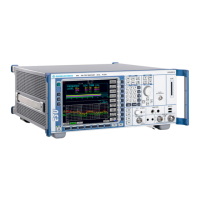R&S ESU Remote Control – Basics
Structure and Syntax of the Device Messages
5.16 Operating Manual 1302.6163.12 - 03
5.6.7 Instrument Model and Command Processing
The instrument model shown in Fig. 5.41 has been made viewed from the stand-
point of the servicing of remote commands. The individual components work inde-
pendently of each other and simultaneously. They communicate by means of so-
called "messages".
Fig. 5.41 Instrument model in the case of remote control by means of the GPIB
5.6.8 Input Unit
The input unit receives commands character by character from the GPIB and col-
lects them in the input buffer. The input unit sends a message to the command rec-
ognition as soon as the input buffer is full or as soon as it receives a delimiter,
<PROGRAM MESSAGE TERMINATOR>, as defined in IEEE 488.2, or the interface
message DCL.
If the input buffer is full, the GPIB traffic is stopped and the data received up to then
are processed. Subsequently the GPIB traffic is continued. If, however, the buffer is
not yet full when receiving the delimiter, the input unit can already receive the next
command during command recognition and execution. The receipt of a DCL clears
the input buffer and immediately initiates a message to the command recognition.
5.6.9 Command Recognition
The command recognition analyses the data received from the input unit. It pro-
ceeds in the order in which it receives the data. Only a DCL is serviced with priority,
a GET (Group Execute Trigger), e.g., is only executed after the commands received
before as well. Each recognized command is immediately transferred to the instru-
ment data base but without being executed there at once.
Syntactical errors in the command are recognized in the command recognition and
supplied to the status reporting system. The rest of a command line after a syntax
error is analyzed further if possible and serviced.
GPIB
Input unit with
input puffer
Command
recognition
Instrument
hardware
Data set
Status
reporting
system
Output unit with
output buffer
GPIB

